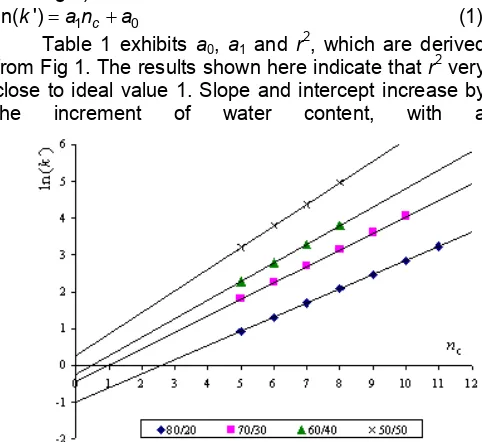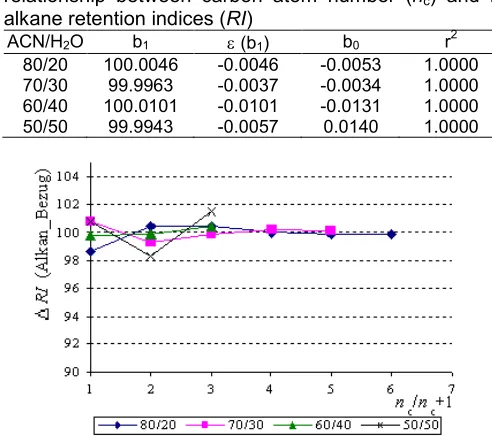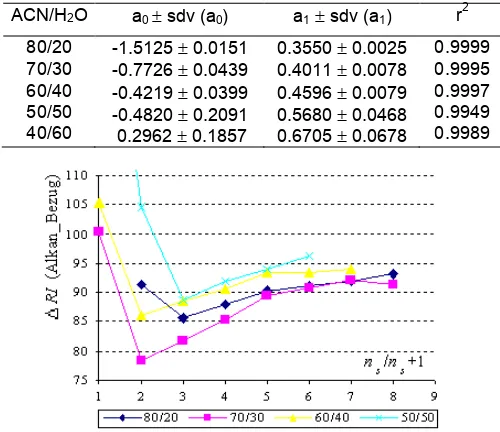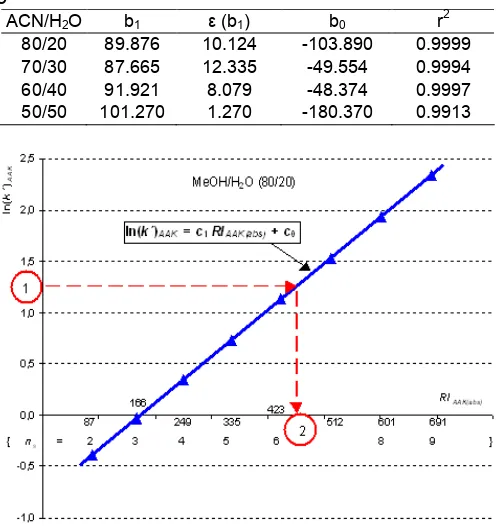ALKYLARYLKETONE HOMOLOGOUS SERIES FOR DETERMINATION OF KOVATS
RETENTION INDICES WITH RP-HPLC USING ACETONITRILE/WATER SYSTEM
Rinaldi Idroes
Department of Chemistry, Faculty of Mathematics and Natural Sciences, Syiah Kuala University, Kampus Darussalam, Banda Aceh, 23111, Indonesia
Received October 6, 2009; Accepted January 20, 2010
ABSTRACT
Some factors such as the changes of the stationary phase, temperature, pH-value, mobile-phase composition and flow rate play a crucial role in effecting the sensitivity of retention times in high performance liquid chromatography (HPLC) system. Utilizing a retention index system is one of the methods to minimize those effects. Besides the mentioned factors, dead-time influences on determining the retention index as well. In comparison with Gas Chromatography (GC), the retention Index determination method in HPLC is still widely discussed, due to the difficulty of utilizing n-alkane as standard. In addition, the solutes in HPLC interact with the mobile-phase, thus the retention behavior also depend on the mobile-phase. Actually, It is difficult to use n-alkanes in HPLC as standards in case of some considerable problems, due to they are very non polar but also large retention times which lack of chromophores. Therefore, using n-alkane in routine analysis could be inconvenient. In comparison with n-alkanes, the alkylarylketones homologous series are stable compounds, commercially available and easily detected by a UV detector. This paper introduces Determination of Kovats Retention Index in the HPLC using Alkylarylketone homologous series and then is connected with n-alkane as a frame of reference. Steroids were used as test substance for calculating Kovats retention index values in acetonitrile/water system.
Keywords:Kovats Retention Index, RP- HPLC, n-alkane, alkylarylketone
INTRODUCTION
It is not advisable to use retention times to characterize the retention behavior, due to its bad reproducibility. Many factors influence retention time in RP-HPLC, the most important factors are the following: temperature, pH value, mobile phase composition, column material, column age and flow-rate. Among retention parameters such as retention time (tR), capacity factor (k´) and retention index (RI) show that retention index is more reproducible and more robust than tRand k´ [1-2]. The dead time (t0) calculation is needed to determine the mentioned retention parameters. There is no possibility to define a unified dead time since it depends on the chromatographic system and the method how dead time is calculated [3]. In this research, the dead time is calculated by applying homologous series (n-alkane) according to the iteration method of Guardino [4].
n-alkane is suggested to be used as retention index scale in HPLC, due to the results directly comparable with retention data from GC [5]. However, it is not discussed here how to compare the retention data based on n-alkane between GC and HPLC system. In contrast to GC in HPLC solutes also interact with the mobile phase, thus the retention data also depend on the mobile phase. It is not easy to use n-alkane in HPLC
as standards in case of two considerable problems. Firstly, they are very non polar, hence in most reversed phase system they show large retention times which restricts their application. Moreover, an additional refractive index detector is needed due to the lack of chromophores. Therefore using n-alkanes in routine analysis is problematic. In comparison with n-alkanes, the alkylarylketone has the advantage that they can be detected spectroscopically. In addition, these homologous series are stable compounds and are commercially available. They have a high UV absorbance at the wavelength of 254 nm, and thus are easily detected by a UV detector [6]. This paper reports Kovats Retention Index Determination in the HPLC by using alkylarylketone homologous series and then is connected with n-alkane as a frame of reference. Steroids were used as test substance for determining absolute retention index values in acetonitrile/water system.
EXPERIMENTAL SECTION
Materials
[(V/V] was used. Acetonitrile for HPLC grade is received from Merck and Water for HPLC grade from Millipore. Various kinds of steroids were used as test substances (Amcinonide, Betamethason-17-valerat, Clobetason-17-butyrat, Clocortolon-21-hexanoat, Clocortolon-21-pivalat, Diflorasondiacetat, Flumetason, Halcinonid, Hydrocortison-17-butyrat and Triamcinolonhexacetonid).
Instrumentation
The column was Lichrospher 100 RP-18 (Merck) with 5m diameter and 125 x 4 mm. Water jacket was self constructed. Thermostat was Haake D8 (Fison), Karlsruhe, Germany, with precision0,02 °C. Valve was Rheodyne No. 7010 with a 20l loop, Cotati, California. Pump was Bischoff model 2200 (serial 903), Leonberg, Germany. Detector was RI-detector model ERC-7510, Erma Optical Works Ltd. Japan, Range: ¼. Polarity: ( - ). Recorder: HP-3394, Hewlett-Packard, Waldbronn, Germany. Dead-volume (V0) was 20 l. Software: Microsoft Excel and Borland C++.
Procedure
The solvents were degassed approximately 10 min with Helium (He). The HPLC equipment with particular refractive-index detector has been pre-run till equilibrium condition before injection. The column was adjusted in water jacket at 30 °C. Solvent-reservoir was put in water jacket and kept at 30 °C constantly. Flow-rate: 1.0 mL/min. Dead-time was calculated according to the method of Guardino [7].
RESULT AND DISCUSSION
The retention behavior of n-Alkane homologous series
The retention behavior of n-alkane homologous series is the basic of Kovats Retention Index concept.
Therefore, it should be investigated firstly the behavior including some parameters such as: ln(k´) against nc, accuracy,RI against nc, ΔRI against nc/nc+1 and dead time calculation as follows.
ln(k´) against nc
The Retention index system is based on equation (1), i.e. for homologous series of n-alkane exist a linear relationship between ln(k´) and carbon number (nc), (see Fig 1).
1 0
ln( ')k a nc a (1)
Table 1 exhibits a0, a1 and r 2
, which are derived from Fig 1. The results shown here indicate thatr2 very close to ideal value 1. Slope and intercept increase by the increment of water content, with a
Fig 1. Linear correlation between n-alkane carbon number (nc) and ln(k´) in ACN/H2O system
Table 1.Regression coefficient values of Fig 1 a0sdv (a0) a1sdv (a1) r
2
80/20 -1.00020.0070 0.38500.0008 1.0000 70/30 -0.4230 0.0076 0.44760.0010 1.0000 60/40 -0.24780.0165 0.50520.0025 1.0000 50/50 0.2793 0.0711 0.58540.0108 1.0000
Table 2.Accuracy of n-alkane retention index in ACN/H2O system Substances nc RI/ε 80/20 70/30 60/40 50/50
n-Pentane 5 RI 500.6 499.7 500.2 499.9
ε + 0.6 - 0.3 + 0.2 - 0.1
n-Hexane 6 RI 599.3 600.5 600.0 600.7
ε - 0.7 + 0.5 0.0 + 0.7
n-Heptane 7 RI 699.8 699.9 699.8 698.9
ε - 0.2 - 0.1 - 0.2 - 1.1
n-Octane 8 RI 800.2 799.7 800.3 800.4
ε + 0.2 - 0.3 + 0.3 + 0.4
n-Nonane 9 RI 900.2 899.9 -
-ε + 0.2 - 0.1 -
-n-Decane 10 RI 1000.1 1000.1 -
-ε + 0.1 + 0.1 -
-n-Undecane 11 RI 1100.0 - -
-Table 3. Regression coefficient values and bias of linear relationship between carbon atom number (nc) and n-alkane retention indices (RI)
ACN/H2O b1 (b1) b0 r2 80/20 100.0046 -0.0046 -0.0053 1.0000 70/30 99.9963 -0.0037 -0.0034 1.0000 60/40 100.0101 -0.0101 -0.0131 1.0000 50/50 99.9943 -0.0057 0.0140 1.0000
Fig 2.Relationship betweenΔRIof n-alkane andnc/nc+1 in ACN/H2O system
Table 4. Dead-time calculation by using of n-alkane homologous series
80/20 70/30 60/40 50/50 t0(min) 1,15 1.00 1,10 1.04
a1 0.0039 0.0045 0.0050 0.0058 a0 -0.870 -0.425 -0.145 0.326 nc n5-n11 n5-n10 n5-n8 n5-n8
S/N 0.147 0.074 0.033 0.457
RI5 500.63 499.72 500.17 499.88 RI6 599.31 600.51 599.97 600.66 RI7 699.76 699.87 699.81 698.92 RI8 800.19 799.72 800.26 800.45
RI9 900.22 899.92 -
-RI10 1000.13 1000.08 -
-RI11 1099.99 - -
-linear function. Lower n-alkane, e.g. with n3 or n4 (Propane or Butane), are in gaseous phase, hence retention index values under 300 till 400 in practice are barely used.
Accuracy
True value of retention index relevance of n-alkane is defined as a fictive number of carbon atom multiplying by 100, e.g. true value for pentane = 500, hexane = 600, heptane = 700, etc. Table 2 shows the accuracy of n-alkane retention index values in ACN/H2O solvent system.
From all solvent compositions show the bias under 1.0. The tendency shows that the increasing of carbon
number can affect better accuracy. The Retention Index was determined according to equation 2.
0
Table 3 indicates a linear correlation between retention index (RI) of n-alkane and the Alkane carbon number (nc) in ACN/H2O solvent system, whereby the RI-values were determined by using n-alkane as the standard.
The following equation is derived from linear indication:
1 c 0
RI b n b (3)
Retention index difference between two neighboring carbon atoms of n-alkane is due to the CH2 group which is equal 100 [7], as well as the slope (b1) of equation (3) is defined.
2 c 1 c 1 100
CH n n
RI RI RI b
(4)
ΔRI against nc/nc+1
ΔRI serves as the character of retention index difference (eq.4) and nc/nc+1 represents the difference of n-alkane carbon atoms respectively, e.g. for Pentane and Hexane is nc/nc+1 = 1, for Hexane and Heptane is nc/nc+1 = 2, etc. Fig 2 describes this relationship for ACN/H2O system.
Equation (4) can be used for characterizing of homologous series deviations. In acetonitrile/water system is shown that ΔRICH2 for n-alkane with shorter chain has smaller deviations (only 1–2 units from 100). In acetonitrile/water 80/20 system ΔRIis 99.9 0.6; in 70/30 system ΔRI is 100.1 0.5; in 60/40 system ΔRI is 100.0 0.4 and in system 50/50 is 100.2 1.7. Moreover, it was demonstrated here that deviations for nc/nc+1 < 3 were smaller.
Dead-time calculation
The dead-time is calculated by using n-alkane as homologous series in ACN/H2O system with varying solvent composition as be shown in Table 4. This calculation was adopted from the method of Guardino et al. [6], in which an iteration is carried out upon the dead time (t0), with slope (a1) and intercept (a0) being calculated using the least squares linear regression. The sum of squares of the deviation between calculated value and known Kovats Indices divided by the number of homologous (S of S/N) was used as a general indication of the accuracy of fit [4].
Fig 3. Linear correlation between carbon number of alkyl chain (ns) and ln(k´) in ACN/H2O system
Table 5.Regression coefficient values (a1anda0) of Fig 3
ACN/H2O a0sdv (a0) a1sdv (a1) r 2
80/20 -1.51250.0151 0.35500.0025 0.9999 70/30 -0.77260.0439 0.40110.0078 0.9995 60/40
50/50 40/60
-0.42190.0399 -0.48200.2091 0.29620.1857
0.45960.0079 0.56800.0468 0.67050.0678
0.9997 0.9949 0.9989
Fig 4. Relationship between ΔRI of alkylarylketone and ns/ns+1
Fig 5. Linear relationship between carbon number of alkyl chain (ns) and absolute retention indices of alkylarylketoneRI(n-alkane scale) in ACN/H2O system
on the RP-HPLC with various homologous series, such as Alkyl aryl ketones and 1-Nitroalkanes.
Table 4 was the dead-time calculation by using n-alkane homologous series without depending on solvent compositions. In comparison with other homologous series, n-alkane exhibited smaller S of S/N than other homologous series, e.g. Alkan-2-ones, Alkyl benzenes and Alkyl aryl ketones [8].
The retention behavior of alkylarylketone homologous series
Due to very large retention time, then it is suggested using alkylarylketone in connecting with n-alkane as a frame of reference. Some parameters for identifying behavior of alkylarylketone should be investigated such as ln(k´) against ns, ΔRI against ns/ns+1 and RI against ns then index Kovats can be calculated as absolute retention index as follows.
ln(k´) against ns
The Retention index system is based on equation (5), i.e. for homologous series of alkylarylketone exists a linear relationship between ln(k´) and carbon number of alkyl chain (ns), see Fig 3.
1 0
ln( ')k a ns a (5)
Table 5 exhibits a0, a1 and r 2
, which are derived from Fig 3. The results shown here indicate thatr2 very close to ideal value 1. Slopes and intercepts increase by the increment of water content and indicate as a linear function.
All r2-values for both solvent systems are larger than 0.9949. The random error of slope (a1) and intercept (a0) was calculated according to Miller et al. [8]. Moreover, the deviations of slopes are smaller than the intercepts. The largest deviations of a0 and a1 exhibited in ACN/H2O system, particularly in composition 40/60.
ΔRI against ns/ns+1
ΔRI serves as the character of retention index difference and ns/ns+1 represents the difference of Alkyl chain carbon number, e.g. for acetophenone and propiophenone is ns/ns+1 = 1, for propiophenone and butyrophenone is ns/ns+1 = 2, etc. Fig 4 describe this relationship for ACN/H2O system.
Table 6.Regression coefficient values and bias from Fig 5
ACN/H2O b1 ε(b1) b0 r2 80/20 89.876 10.124 -103.890 0.9999 70/30 87.665 12.335 -49.554 0.9994 60/40 91.921 8.079 -48.374 0.9997 50/50 101.270 1.270 -180.370 0.9913
Fig 6. Absolute retention index determination of test substance
Table 7. Retention Index values of alkylarylketone in ACN/H2O by using n-alkane as the standard
Substances 80/20 70/30 60/40 50/50
Acetophenone - 36 38 -115
Propiophenone 77 136 143 42 Butyrophenone 169 215 229 146 Valerophenone 254 297 318 235 Hexanophenone 342 382 408 327 Heptanophenone 433 471 502 421 Octanophenone 524 562 595 517 Nonanophenone 616 654 689
-Decanophenone 709 745 -
-Table 8. Kovats (absolute) retention index values of steroids in ACN/H2O
No Substances 60/40 50/50
1 Amcinonide 334 320
2 Betamethason-17-valerat 281 261 3 Clobetason-17-butyrat 456 460 4 Clocortolon-21-hexanoat 579 600 5 Clocortolon-21-pivalat 501 512
6 Diflorasondiacetat 231 222
7 Flumetason 361 367
8 Halcinonid 322 306
9 Hydrocortison-17-butyrat 403 394 10 Triamcinolonhexacetonid 534 541
ΔRI-values lay fewer than 100.
RI against ns
A linear correlation between carbon number of alkyl chain (ns) and Kovats retention indices of alkylarylketone RI (n-alkane scale) in ACN/H2O system is shown in Table 5. Kovats retention indices of alkylarylketone were calculated by using n-alkane as the standard. Table 6 exhibitsb1,b0,ε(b1) andr
2
derived from Fig 5.
The following expression is obtained from linear equation:
1 s 0
RI b n b (6)
ε(b1) specify a systematic error of slopeb1, as reference value, where conventionally for this purpose according to Kovats equal to 100 (refer to equation 4). The Kovats retention indices of alkylarylketone in ACN/H2O system affect a systematic error circa 8, and the average of slopes (b1) from this linear correlation at this solvent composition (Table 6) is 92. Dead-time calculation (t0) for Table 6 was calculated by using n-alkane according to iteration procedure [3]. The r2-values show good correlation between 0.9913 and 0.9999.
Absolute retention index determination
Kovats retention index of substance according to alkylarylketone as the standard can be calculated by
connecting with n-alkane as the primary standard. An example here is system MeOH/H2O (80/20) in Fig 6, where the linear relationship between ln(k´) (Fig 3) and Kovats (absolute) retention index values of alkylarylketone (Table 7) are described.
From Fig 6 the following equation could be derived:
1 ( ) 0
ln( ´)k Alkylarylketone c RIAlkylarylketone absolute c (7)
ln(k´)alkylarylketone is alkylarylketone capacity factor, RIalkylarylketone(absolute) is alkylarylketone Kovats (absolute) retention index and c1 and c0 are linear regression coefficients. On the basis of ln(k´) againstns(Fig 3) and RI against ns (Fig 5) were all linear, consequently, ln(k´)alkylarylketone against retention index absolute (RIalkylarylketone(absolute)) must be linear too. Therefore, RI values of Substance based on index system absolute could be determined as follows:
tan 0
CONCLUSION
n-alkane homologous series (from Pentane) are very suitable as the standard for retention index calculation in the RP-HPLC, although of very non polar and lacking of chromophore properties, and n-alkane fit well in dead time calculation as well. More over n-alkane indicate good reproducibility and is also no representative of this homologous series affected unusual phenomena.
The most important finding in this research is the possibility of adjusting the Kovats retention index system in the HPLC using alkylarylketone homologous series which are then connected with n-alkane as a frame of reference.
ACKNOWLEDGEMENT
The author would like to thank sincerely to DAAD (German Academic Exchange Service) for research stay scholarship and Prof. Dr. S. Ebel for kindly research work supervising.
REFERENCES
1. Smith, R.M., 1995,J. Chromatogr. Libr.,57. 2. Ettre, L.S., 2003, Chromatographia, 58, 7-8,
491-494.
3. Wätzig, H., 1989, Dissertation, University of Würzburg.
4. Didaoui, L., Touabet, A., Ahmed, A.Y.B.H., Meklati, B.Y., and Engewald W., 1999, J. High. Resolut. Chromatogr., 22, 10, 559-564.
5. Harangi, J., 2003,J. Chromatogr. A, 993, 187-195. 6. Baker, J.K., Ma, C.Y., 1979, J. Chromatogr., 169,
107-117.
7. Guardino, X., Albaiges, J., Firpo, G., Rodrigues-Vinals, R., Gassiot, M., 1976,J. Chromatogr., 118, 1, 13-22.



